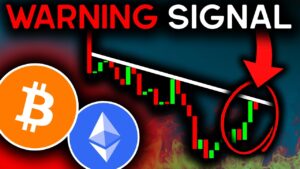Is a U.S. Recession Looming in 2025? Exploring the Impact of Trump’s Tariffs
In the wake of Donald Trump’s tariff implementation, economic uncertainty has surged, and concerns about a U.S. recession are becoming more pronounced. Financial institutions like JP Morgan and Goldman Sachs have revisited their economic forecasts, adjusting recession predictions significantly. As stock markets face turmoil, cryptocurrencies struggle for stability, and hard assets react, the pressing question arises: are we on the brink of a recession in 2025?
Trump’s Tariff: Harbinger of Economic Growth or Economic Downturn?
When Donald Trump enacted tariffs, he promised a resurgence of American wealth, a boost to domestic production, and the preservation of jobs. However, analysts are painting a different picture, positing that these tariffs could contribute to an economic downturn rather than enhance prosperity. The tariffs, universally applied, have incited significant reactions from affected countries, notably China, the EU, and Japan. In response, these nations are strategizing on how to confront the trade barriers, including retaliatory measures like China’s implementation of reverse tariffs. As these dynamics unfold, many market commentators are forecasting the onset of a financial crisis, exacerbated by tariffs adversely impacting trade relations and economic growth.
The Ripple Effect: Analyzing Financial Institutions’ Recession Predictions
Recession predictions are starkly rising, as major financial institutions are recalibrating their assessments. JP Morgan has increased the likelihood of a recession to 60% by 2025, attributing this likelihood to the disruptive policies stemming from the Trump administration’s tariffs. Meanwhile, Goldman Sachs revised its recession forecast from 20% to 35%. Other notable predictions include Oxford Economics forecasting a core inflation rate of 4% and GDP growth dropping to a mere 1.4%. Similarly, Moody’s Analytics anticipates a grim future where unemployment could reach 7.5% and GDP contracts by 2% if retaliatory measures persist. These financial insights create a gloomy outlook, raising the alarm for investors and economists alike.
Investors’ Sentiments: Trends from Recent Data
Investor sentiments are mirroring the predictions posed by financial heavyweights. Recent data from Polymarket indicates that the probability of a U.S. recession has surged to 57%, reflecting a climate of fear and uncertainty. Such forecasts are fostering a bearish sentiment among investors, as the apprehension grows over market stability and economic viability. Contributing to this growing unease, Federal Reserve Chair Jerome Powell has articulated his reservations regarding the impact of the tariffs, pointing out that their scale was larger than initially anticipated and warning of a potentially severe economic fallout.
The Market Reaction: Understanding Stock and Cryptocurrency Trends
The reaction of the financial markets to these economic forecasts has been palpable. Stock prices are descending, and cryptocurrency markets are experiencing their share of turmoil as well. Hard assets, traditionally seen as safe havens during economic distress, are not immune to the downturn either. The intertwined fate of various asset classes serves to underline the uncertainty prevailing in the market. The compounding fears of a recession are shaking investor confidence, leading to heightened volatility and a reevaluation of investment strategies across the board.
The Road Ahead: Anticipating Economic Changes in 2025
As we look towards 2025, several economic indicators suggest a landscape rife with potential turning points. Jerome Powell’s cautionary commentary, along with Polymarket’s probability data and JP Morgan’s recession prediction, compounds investor uncertainty about the future. The direction of economic recovery now hinges significantly on the Federal Reserve’s next steps and any developments regarding Trump’s tariff policies. All eyes are closely monitoring the Fed’s decisions and market reactions as we march towards a potentially pivotal year, hoping for signals of stability amid the ominous forecasts.
Conclusion: Preparing for Future Economic Impacts
In summary, the introduction of Donald Trump’s tariffs has spurred a wave of economic anxiety reflected in increased recession odds from reputable institutions. With JP Morgan and Goldman Sachs amplifying their projections and investor sentiments shifting towards caution, the anticipation of a recession in 2025 looms large. The ramifications of these tariffs echo throughout the financial markets, underscoring the need for vigilant observation of Federal Reserve actions and broader economic indicators. As the economic landscape continues to evolve, stakeholders must remain informed and adaptive to navigate the complexities ahead.
In this climate of uncertainty, staying updated on economic changes and preparing for various scenarios will be essential for investors and policymakers alike. Preparing for the potential of a recession could allow for strategic positioning, ensuring resilience in the face of an unpredictable economy.
Frequently Asked Questions (FAQs)
-
What are the economic implications of Trump’s tariffs?
- Trump’s tariffs have triggered significant economic uncertainty, raising fears of a potential recession in the U.S.
-
What is Jerome Powell’s stance on the current economic situation?
- Federal Reserve Chair Jerome Powell has expressed concerns over the larger-than-expected impact of tariffs and has hinted at significant economic fallout.
-
How are financial markets reacting to the news about a potential recession?
- The stock market is experiencing declines, cryptocurrency values are also down, and the overall economic sentiment is one of instability.
-
What are investors predicting about the likelihood of a recession?
- Recent data indicates that investors believe the probability of a U.S. recession is growing, with numbers rising to 57%.
- What should investors watch for regarding economic changes?
- Investors should closely monitor developments from the Federal Reserve and any updates regarding tariff policies to gauge the economic trends leading into 2025.
This article aims to provide a comprehensive overview of the current economic climate influenced by Trump’s tariffs and its potential trajectory towards a recession in 2025.
















